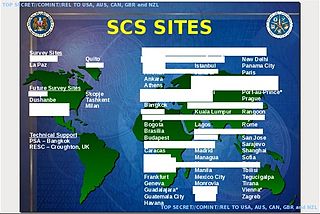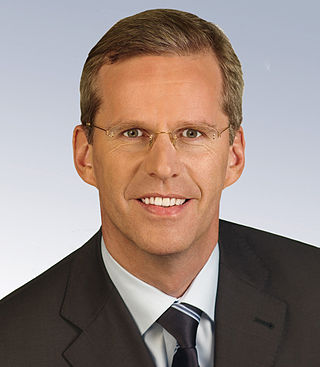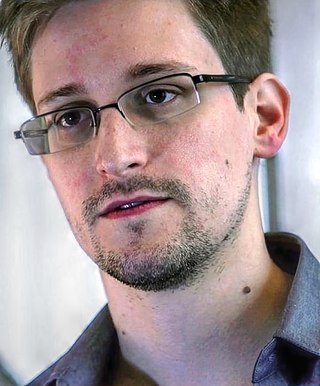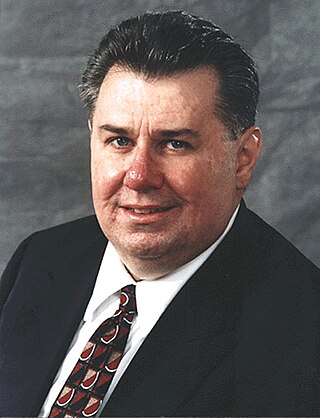Related Research Articles

ECHELON, originally a secret government code name, is a surveillance program operated by the five signatory states to the UKUSA Security Agreement: Australia, Canada, New Zealand, the United Kingdom and the United States, also known as the Five Eyes.

The National Security Agency (NSA) is a national-level intelligence agency of the United States Department of Defense, under the authority of the Director of National Intelligence (DNI). The NSA is responsible for global monitoring, collection, and processing of information and data for foreign and domestic intelligence and counterintelligence purposes, specializing in a discipline known as signals intelligence (SIGINT). The NSA is also tasked with the protection of U.S. communications networks and information systems. The NSA relies on a variety of measures to accomplish its mission, the majority of which are clandestine. The existence of the NSA was not revealed until 1975. The NSA has roughly 32,000 employees.

The United Kingdom – United States of America Agreement is a multilateral agreement for cooperation in signals intelligence between Australia, Canada, New Zealand, the United Kingdom, and the United States. The alliance of intelligence operations is also known as the Five Eyes. In classification markings this is abbreviated as FVEY, with the individual countries being abbreviated as AUS, CAN, NZL, GBR, and USA, respectively.

The Special Collection Service (SCS), codenamed F6, is a highly classified joint U.S. Central Intelligence Agency–National Security Agency program charged with inserting eavesdropping equipment in difficult-to-reach places, such as foreign embassies, communications centers, and foreign government installations. Established in the late 1970s and headquartered in Beltsville, Maryland, the SCS has been involved in operations ranging from the Cold War to the Global War on Terrorism.

Clemens Binninger is a German politician of the CDU. Binninger was a member of the Bundestag from 2002 until 2017.

Laura Poitras is an American director and producer of documentary films.

The Utah Data Center (UDC), also known as the Intelligence Community Comprehensive National Cybersecurity Initiative Data Center, is a data storage facility for the United States Intelligence Community that is designed to store data estimated to be on the order of exabytes or larger. Its purpose is to support the Comprehensive National Cybersecurity Initiative (CNCI), though its precise mission is classified. The National Security Agency (NSA) leads operations at the facility as the executive agent for the Director of National Intelligence. It is located at Camp Williams near Bluffdale, Utah, between Utah Lake and Great Salt Lake and was completed in May 2014 at a cost of $1.5 billion.

Boundless Informant is a big data analysis and data visualization tool used by the United States National Security Agency (NSA). It gives NSA managers summaries of the NSA's worldwide data collection activities by counting metadata. The existence of this tool was disclosed by documents leaked by Edward Snowden, who worked at the NSA for the defense contractor Booz Allen Hamilton. Those disclosed documents were in a direct contradiction to the NSA's assurance to United States Congress that it does not collect any type of data on millions of Americans.

Edward Joseph Snowden is a United States and naturalized Russian citizen who was a computer intelligence consultant and whistleblower who leaked highly classified information from the National Security Agency (NSA) in 2013 when he was an employee and subcontractor. His disclosures revealed numerous global surveillance programs, many run by the NSA and the Five Eyes intelligence alliance with the cooperation of telecommunication companies and European governments and prompted a cultural discussion about national security and individual privacy.

Tempora is the codeword for a formerly-secret computer system that is used by the British Government Communications Headquarters (GCHQ). This system is used to buffer most Internet communications that are extracted from fibre-optic cables, so these can be processed and searched at a later time. It was tested from 2008 and became operational in late 2011.

Perry Fellwock is a former National Security Agency (NSA) analyst and whistleblower who revealed the existence of the NSA and its worldwide covert surveillance network in an interview, using the pseudonym Winslow Peck, with Ramparts in 1971. At the time that Fellwock blew the whistle on ECHELON, the NSA was a nearly unknown organization and among the most secretive of the US intelligence agencies. Fellwock revealed that it had a significantly larger budget than the Central Intelligence Agency (CIA). Fellwock was motivated by Daniel Ellsberg's release of the Pentagon Papers. Today, Fellwock has been acknowledged as the first NSA whistleblower.

The practice of mass surveillance in the United States dates back to wartime monitoring and censorship of international communications from, to, or which passed through the United States. After the First and Second World Wars, mass surveillance continued throughout the Cold War period, via programs such as the Black Chamber and Project SHAMROCK. The formation and growth of federal law-enforcement and intelligence agencies such as the FBI, CIA, and NSA institutionalized surveillance used to also silence political dissent, as evidenced by COINTELPRO projects which targeted various organizations and individuals. During the Civil Rights Movement era, many individuals put under surveillance orders were first labelled as integrationists, then deemed subversive, and sometimes suspected to be supportive of the communist model of the United States' rival at the time, the Soviet Union. Other targeted individuals and groups included Native American activists, African American and Chicano liberation movement activists, and anti-war protesters.

Ongoing news reports in the international media have revealed operational details about the Anglophone cryptographic agencies' global surveillance of both foreign and domestic nationals. The reports mostly emanate from a cache of top secret documents leaked by ex-NSA contractor Edward Snowden, which he obtained whilst working for Booz Allen Hamilton, one of the largest contractors for defense and intelligence in the United States. In addition to a trove of U.S. federal documents, Snowden's cache reportedly contains thousands of Australian, British, Canadian and New Zealand intelligence files that he had accessed via the exclusive "Five Eyes" network. In June 2013, the first of Snowden's documents were published simultaneously by The Washington Post and The Guardian, attracting considerable public attention. The disclosure continued throughout 2013, and a small portion of the estimated full cache of documents was later published by other media outlets worldwide, most notably The New York Times, the Canadian Broadcasting Corporation, the Australian Broadcasting Corporation, Der Spiegel (Germany), O Globo (Brazil), Le Monde (France), L'espresso (Italy), NRC Handelsblad, Dagbladet (Norway), El País (Spain), and Sveriges Television (Sweden).

Global mass surveillance can be defined as the mass surveillance of entire populations across national borders.

STATEROOM is the code name of a highly secretive signals intelligence collection program involving the interception of international radio, telecommunications and Internet traffic. It is operated out of the diplomatic missions of the signatories to the UKUSA Agreement and the members of the ECHELON network including Australia, New Zealand, United Kingdom, Canada and the United States.

This timeline of global surveillance disclosures from 2013 to the present day is a chronological list of the global surveillance disclosures that began in 2013. The disclosures have been largely instigated by revelations from the former American National Security Agency contractor Edward Snowden.
The German Parliamentary Committee investigation of the NSA spying scandal was started on March 20, 2014, by the German Parliament in order to investigate the extent and background of foreign secret services spying in Germany in the light of the Global surveillance disclosures (2013–present). The Committee is also in search of strategies on how to protect telecommunication with technical means.
Regin is a sophisticated malware and hacking toolkit used by United States' National Security Agency (NSA) and its British counterpart, the Government Communications Headquarters (GCHQ). It was first publicly revealed by Kaspersky Lab, Symantec, and The Intercept in November 2014. The malware targets specific users of Microsoft Windows-based computers and has been linked to the US intelligence-gathering agency NSA and its British counterpart, the GCHQ. The Intercept provided samples of Regin for download, including malware discovered at a Belgian telecommunications provider, Belgacom. Kaspersky Lab says it first became aware of Regin in spring 2012, but some of the earliest samples date from 2003. Among computers infected worldwide by Regin, 28 percent were in Russia, 24 percent in Saudi Arabia, 9 percent each in Mexico and Ireland, and 5 percent in each of India, Afghanistan, Iran, Belgium, Austria, and Pakistan.
Targeted surveillance is a form of surveillance, such as wiretapping, that is directed towards specific persons of interest, and is distinguishable from mass surveillance. Both untargeted and targeted surveillance is routinely accused of treating innocent people as suspects in ways that are unfair, of violating human rights, international treaties and conventions as well as national laws, and of failing to pursue security effectively.

The Consolidated Intelligence Center in Wiesbaden, Germany, is a controversial US intelligence facility under construction by the US Army Europe, located on the grounds of the Lucius D. Clay Barracks in Wiesbaden-Erbenheim, formerly Wiesbaden Army Airfield, about eight kilometres southeast of downtown Wiesbaden. The purpose of the facility, according to the US Army, is to support US forces with tactical theatre-of-war support and strategic intelligence functions. As such, it is implied that data fusion would also take place at this location.
References
- 1 2 3 4 "New NSA Revelations: Inside Snowden's Germany File". Der Spiegel . June 18, 2014. Retrieved 15 July 2014.
- ↑ "NSA Turned Germany Into Its Largest Listening Post in Europe". The Intercept. Retrieved 2021-04-27.
- ↑ "New Snowden Revelations on NSA Spying in Germany". Der Spiegel . Retrieved 2021-04-27.
